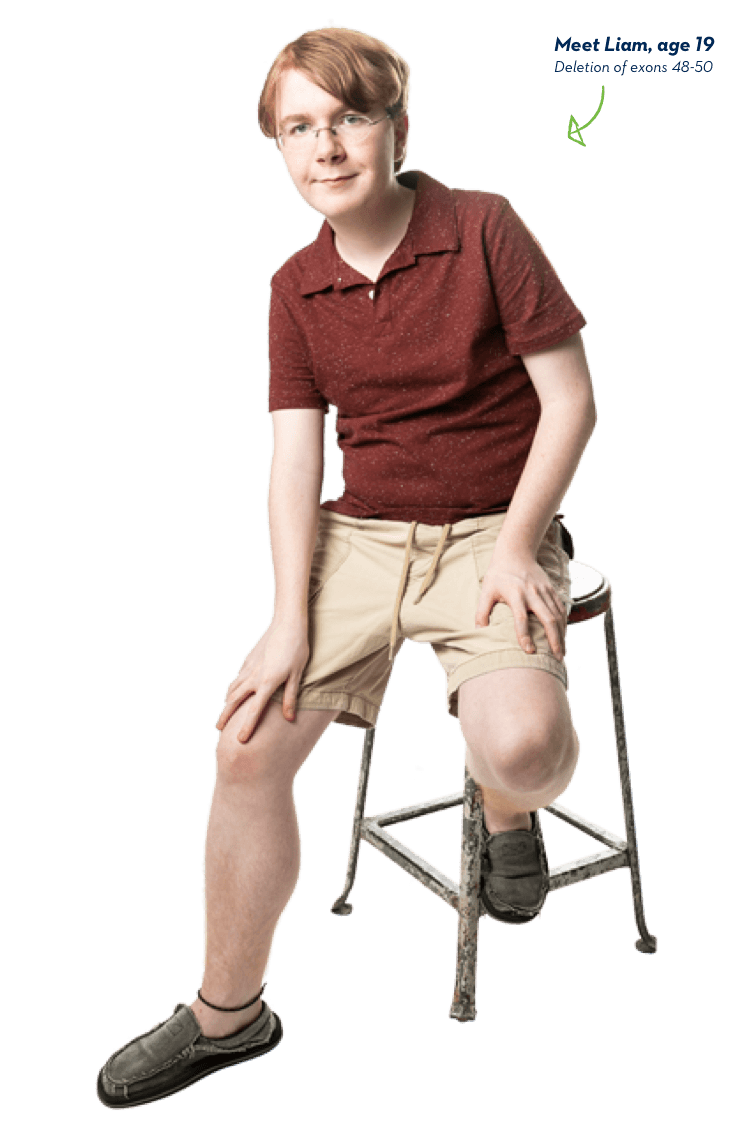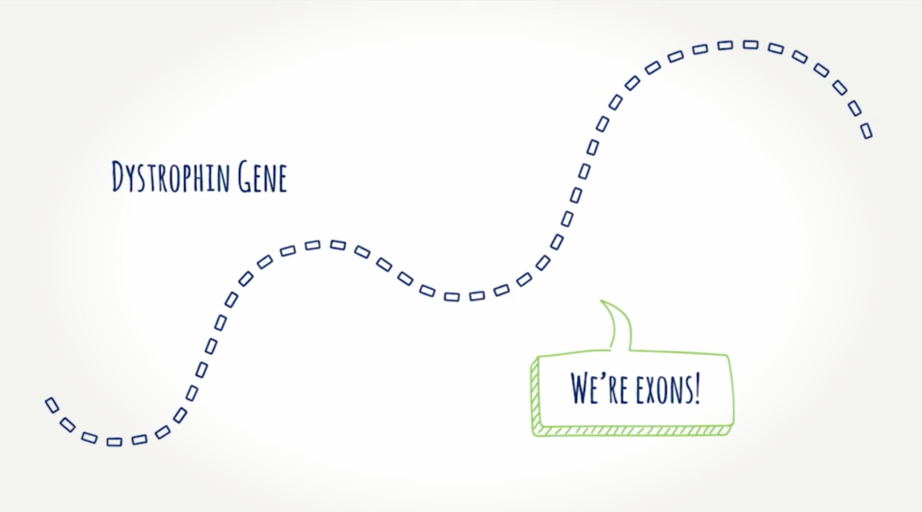
The genetic mutation behind Duchenne.
Understanding the cause of Duchenne begins with understanding the role of proteins and genes in how our bodies function.
Proteins are necessary for many important functions in the body, such as digesting our food, growing our bones, or—in the case of the protein called dystrophin—helping our muscles work properly.
Genes are made up of segments, called “exons,” that tell our cells which proteins to make. The dystrophin gene is made up of 79 exons that, when linked together, form the instructions for making dystrophin.

Meet Liam, age 19
Deletion of exons 48-50

What is a genetic mutation?
A mutation is a change in a person's DNA. Mutations range in size from a small (a single rung on a ladder) to a large segment of DNA. Every mutation causes a different effect on our bodies. A mutation on the dystrophin gene means dystrophin is not produced—resulting in Duchenne.
3 common types of mutations.
Large deletions
One or more exons are missing
of people with Duchenne
About 14% of people diagnosed with Duchenne have a genetic mutation that is amenable to EXONDYS 51. Learn what this means.
Large duplications
One or more exons are duplicated
of people with Duchenne
(Not treatable with EXONDYS 51)
Other changes
Small deletions or interruptions in the instructions
of people with Duchenne
(Not treatable with EXONDYS 51)
EXONDYS 51 is used to treat Duchenne in patients who have a confirmed mutation in the dystrophin gene that can be treated by skipping exon 51. EXONDYS 51 was approved under accelerated approval. Accelerated approval allows for drugs to be approved based on a marker that is considered reasonably likely to predict a clinical benefit. EXONDYS 51 treatment increased the marker, dystrophin, in skeletal muscle in some patients. Verification of a clinical benefit may be needed for EXONDYS 51 to continue to be approved.
The importance of genetic testing.
While there is presently no cure for Duchenne, advances in research offer hope. Genetic testing can now pinpoint the specific exons that are missing from the dystrophin gene. That’s why it’s so important for every child living with Duchenne to have a current genetic test—and for parents to understand the results.
If your child has a confirmed diagnosis of Duchenne, have they had a genetic test?
No.
Now is the time to talk to your child's doctor about testing.
Learn about genetic testing.
Yes,
a recent test, but I‘m not sure about the results.

Ask your child’s doctor to review the test to see if the genetic mutation is identified. Learn how to read the test results yourself.
Yes,
but it was several years ago.
Test methods have improved in recent years. Talk to your doctor about a retest to identify the mutation.

How is a genetic test performed? Getting a genetic test usually involves providing a blood or saliva sample.
1.
To confirm a Duchenne diagnosis
2.
To identify the genetic mutation and explore possible therapy options
3.
To facilitate potential clinical trial participation
4.
To assist with family planning
Ready to talk to your child’s doctor?
Our helpful Doctor Discussion Guide has information on what to ask during an appointment.

Related FAQs
A genetic test is the only way for your child's doctor to identify your child's mutation and determine if the mutation is amenable to treatment with EXONDYS 51. Learn how genetic mutations are identified.
Weekly infusions of EXONDYS 51 helped the body make a shorter form of the dystrophin protein in some boys. View the results from clinical studies.
EXONDYS 51 is used to treat Duchenne in patients who have a confirmed mutation in the dystrophin gene that can be treated by skipping exon 51. EXONDYS 51 was approved under accelerated approval. Accelerated approval allows for drugs to be approved based on a marker that is considered reasonably likely to predict a clinical benefit. EXONDYS 51 treatment increased the marker, dystrophin, in skeletal muscle in some patients. Verification of a clinical benefit may be needed for EXONDYS 51 to continue to be approved.

